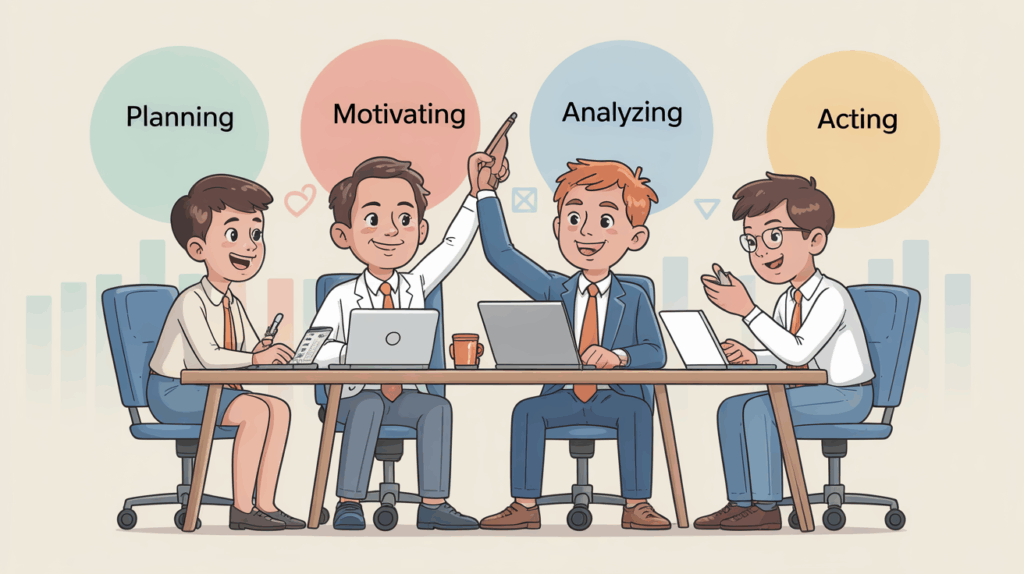🌱 Introduction
In today’s workplace, leadership comes in many forms—and understanding mbti leadership styles offers a unique way to appreciate those differences. Some leaders inspire through vision, others through structure or empathy. The Myers–Briggs framework helps us decode how each personality type motivates, influences, and makes decisions.
While traits like communication and accountability are universal, the way they manifest depends on personality. This post explores six distinctive mbti leadership styles that show how influence isn’t one-size-fits-all—it’s a reflection of who we are.
True leadership, in this context, becomes less about hierarchy and more about human connection. The ability to understand the motivations, fears, and strengths of each type can redefine how we build teams, nurture potential, and sustain performance. By decoding how personalities lead, we reveal the emotional architecture behind great organizations.

🔮 Personality Overview
Leadership is not limited to extroverts or executives; it’s about how we channel our dominant cognitive functions. Each MBTI type leads differently based on its strengths and stressors.
- ENTJ – The Commanding Strategist
Goal-oriented and decisive, ENTJs drive progress through organization and determination. Their influence lies in clarity, confidence, and execution. - ENFJ – The Empathetic Motivator
ENFJs lead with heart. They connect emotionally, inspire purpose, and create harmony. Their charisma lies in their ability to see potential in others. - INTJ – The Vision Architect
Quietly powerful, INTJs build structured paths toward long-term success. They lead with analysis, foresight, and systems thinking. - ISTJ – The Reliable Administrator
Orderly and dependable, ISTJs guide teams through clear procedures and fairness. Their leadership thrives in consistency and reliability. - INFP – The Idealistic Guide
Compassionate and values-driven, INFPs lead by inspiring authenticity and creativity. They influence through integrity rather than authority. - ESTP – The Dynamic Problem-Solver
Bold and adaptive, ESTPs take action quickly. They inspire trust in crises, turning chaos into opportunity.
Together, these patterns reveal that mbti leadership styles are as diverse as the teams they lead.
Each type has its own rhythm of influence. Some motivate through vision and inspiration, others by creating order or offering emotional grounding. Recognizing these rhythms not only improves team dynamics but also helps prevent burnout and miscommunication between contrasting styles. When every personality contributes authentically, leadership becomes a collective force rather than a single voice.
⚔️ Comparisons
When comparing leadership across types, the distinction often lies between Thinking (T) and Feeling (F) approaches.
- Thinking leaders (ENTJ, INTJ, ISTJ) emphasize logic, systems, and measurable results.
- Feeling leaders (ENFJ, INFP) focus on morale, emotional wellbeing, and personal growth.
Meanwhile, Sensing (S) leaders create order through practicality, while Intuitive (N) leaders challenge convention through innovation.
The combination of these preferences determines whether a leader inspires stability or transformation—a crucial insight for understanding mbti leadership styles in modern organizations.
💡 Lessons
From analyzing mbti leadership styles, several lessons emerge:
- There is no “best” leadership type—each succeeds in a different context.
- Self-awareness strengthens influence; knowing your natural tendencies improves decision-making.
- The best teams combine logical and emotional leadership to balance efficiency with empathy.
- Leadership growth begins when we stop copying others and start refining our authentic style.
By understanding how personality shapes influence, we move from leadership as authority to leadership as connection.
🌟 Final Thoughts
The world doesn’t need one type of leader—it needs all of them.
The diversity of mbti leadership styles reminds us that influence flows from authenticity. A true leader inspires others not by demanding loyalty, but by embodying purpose.
No matter your type, you lead best when you lead as yourself—with self-awareness, consistency, and integrity. When we embrace the full spectrum of leadership styles, we build organizations that are not only productive, but profoundly human.